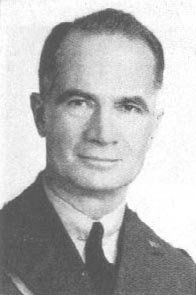General David Petraeus, one of our best generals, liked U.S. Grant because he was effective at every level of command. It is my understanding soldiers can reach a plateau. Some are effective battalion commanders but go no further. Others are skilled with a regiment. Finally, there are division, corps, and army commanders. Patton was adept at the last.

Terry de la Mesa Allen (April 1, 1888-September 12, 1969) was an effective, able division commander who served under General Patton. His grandfather was a Spanish national who fought at Gettysburg on the Union side.
In 1907 Allen received an appointment to West Point. He was later dismissed from the academy because he began to stutter, fell behind in his classes, and failed courses in mathematics and gunnery and ordinance. Undeterred, Allen enrolled in Catholic University of American and received a B.A. in 1912.
Allen was a captain when the United States entered World War I in 1917. He distinguished himself in combat and won the Silver Star at the battle of St. Mihiel. Also awarded the Purple Heart, for he was shot through the jaw and mouth, Allen never stuttered again.
In the interwar years Major Allen served in Texas. In the 1920 Olympics he won a bronze medal in polo. He attended the Command and General Staff School where he finished 221/241. Dwight Eisenhower finished first. Allen also attended the Infantry School at Fort Benning. General George C. Marshall gave him very high marks on his efficiency report and said “by training, temperament, and experience highly qualified as a leader.” He felt Allen was qualified to lead a regiment and division.
The United States began its war against Germany indirectly by landing in North Africa in 1942. Major General Allen commanded the First Infantry Division, the Big Red 1. The division participated in the Tunisian and Sicily campaigns.
In Tunisia the division earned a reputation for carousing, “leaving a trail of looted wine shops and outraged mayors.”
Omar Bradley, the corps commander, was critical of both Terry and Theodore Roosevelt, Jr., his assistant division commander. He said, “They looked at discipline as an unwelcome crutch to be used by less able and personable commanders” Bradley also said, “None excelled Allen in the leadership of troops.”
General George Patton liked Allen even though they frequently argued and even insulted one another. The Big Red 1 carried out the most difficult landing in Sicily.
General Allen was later reassigned to the United States where he took command of the 104 Infantry Division, the Timberwolf Division. He was featured on the cover of Time Magazine in August 1943.
The 104th consisted of 34,000 men and fought for 195 straight days in the Netherlands and Germany. Allen continued to think independently and display a hearty contempt for “chickens- -t regulations” which interfered with combat readiness.
General Allen’s principles for combat success were these: “Find ‘em, ‘fix ‘em, fight ‘em, take the high ground, inflict the maximum damage to the enemy with minimum damage to ourselves, night attack, night attack, night attack.” His HQ was far forward and as close to the front line as possible.
Allen trained his men constantly. Successful night attacks required “well-disciplined troops, training that taught maneuver in the dark so there was not confusion, skilled map reading, and control, secrecy, and vigor in the execution.”
Veterans who served with Terry remember him as confident, determined, stubborn, and aggressive. General Allen did not tolerate unshaven or slovenly troops. On the other hand, he slept on the ground, and was unconcerned about his appearance. He frequently went without haircuts and clean uniforms.
Major General Allen died in September 1969 in Texas. He is buried with his wife and son. (All material was gleaned from Wikipedia, the Free Encyclopedia)
General Allen had an Aries Sun and Sagittarius Moon. Mercury was conjoined with Venus in Pisces, and both were squared by the Moon. His Sun was trine to the Moon and Jupiter. The first indicates good adjustment. It was in opposition to Uranus which shows self-willed perversity and stubbornness. Jupiter trine Saturn often indicates a steady rise. The two planets in Sagittarius probably contributed to his casual approach toward parade ground pomp and show and his ability to get along with all of his men. Surprisingly enough, Mars had only one aspect, a square from Saturn.
